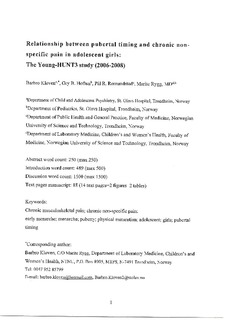Relationship between pubertal timing and chronic nonspecific pain in adolescent girls: The Young-HUNT3 study (2006-2008)
Journal article, Peer reviewed
Accepted version
Permanent lenke
http://hdl.handle.net/11250/2489625Utgivelsesdato
2017Metadata
Vis full innførselSamlinger
Sammendrag
The aim of this study was to examine a possible relationship between early puberty and chronic nonspecific pain in 13- to 18-year-old girls. All adolescents in Nord-Trøndelag County, Norway, were invited to participate in the Young-HUNT3 study (2006-2008). Of the invited girls, 81% answered the questionnaire and of these 3982 were 13 to 18 years of age. Menarche and perceived physical maturation were used as exposure measures. Early menarche was defined as <12 years, normal menarche as ≥12 and <14 years, and late menarche as ≥14 years. Perceived physical maturation was divided into maturing earlier, the same or later than others of their own age. The main outcome measure was chronic nonspecific pain, defined as pain in at least one location not related to any known disease or injury, for at least once a week during the last 3 months. The median age at menarche was 13.2 years. Chronic nonspecific pain was more prevalent among girls with early menarche (68%, 95% CI: 64%-72%) compared to girls with either normal (55%, 95% CI: 53%-57%), late (50%, 95% CI: 46%-54%), or no menarche (35%, 95% CI: 29%-40%). The association persisted after adjusting for age, body mass index, socioeconomic factors, and anxiety and depression. A similar association was found between girls that perceived themselves as earlier physically matured than their peers and chronic nonspecific pain. Headache/migraine was the most common type of chronic nonspecific pain regardless of menarcheal age. In all reported locations, pain was more prevalent in the group with early menarche compared to normal or late menarche.
